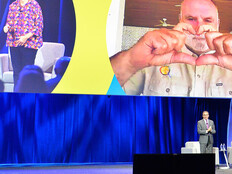No doubt, healthcare is in a time of vast change. Understanding how to approach that change can be daunting for any organization that’s not a technology company in the heart of Silicon Valley.
The College of Healthcare Information Management Executives aims to help healthcare IT leaders innovate, collaborate, share best practices and more, all in the name of improving quality and efficiency in patient care. HealthTech spoke with CHIME President and CEO Russell Branzell about “fourth-revolution technology,” a new era in security and what leaders can do to take on the rapidly changing healthcare landscape at pace.
MORE FROM HEALTHECH: Check out all of our coverage from the 2018 CHIME Fall Forum.
HEALTHTECH: What are the major issues facing healthcare right now?
BRANZELL: Health IT, like the healthcare industry at large, is at an inflection point. Alongside large-scale changes like payment reform, the shift toward consumerism and globalization, we’re entering a new era of technology, fourth-revolution technology, which encompasses 5G, artificial intelligence, neural networking, drones and chatbots — not to mention that mobile devices have matured to the point where there are very few, if any, communication limitations. These tools are being introduced not just to the healthcare industry, but to industries everywhere.
Healthcare has taken on periods of great technical change in the past, but it’s never been like this. Previously, we’ve introduced software that has helped to digitize organizations over a long period of time. This next wave of technology is all going to happen in a compressed time period: over the next five to 10 years.
The impact will be that it will flatten the earth, so to speak, and create a hypercompetitive environment. The way we deliver care will completely change. There will still be healthcare that’s hands-on, but through these new tools people will be empowered to control their own consumer-based care. We’ll get most of our care in our homes or while we’re mobile, anywhere, and this will significantly alter not only the way that technology is used, but also the way in which care is being provided.
HEALTHTECH: How are you already seeing the industry change with the introduction of these new technologies?
BRANZELL: I don’t think it’s a coincidence that we’re seeing organizations like Google and Amazon — organizations with AI expertise — come into the healthcare space. We’re starting to see entire service offerings in the security space that are based around AI, tools that do all the predictive stuff naturally at a computing level, whereas it used to be that humans had to take the data, analyze it and produce a result.
This isn’t the same game we’ve always played, which means that to catch up with the rate of change, healthcare has a lot of educating, a lot of engaging, a lot of networking and a lot of relationship-building it needs to do. There’s a whole new way we’re going operate, and that’s exciting but a little scary, and more than anything it’s an amazing opportunity to do some really neat things in this industry.

HEALTHTECH: How can healthcare IT leaders engage with business leaders, each other and those outside the industry to reckon with these innovations?
BRANZELL: A major opportunity to arise from this is that traditional silos are breaking down. All of a sudden, the payer market has started to employ physicians. Google and Amazon are part of the healthcare supply chain. Anything is possible.
So how do we figure all this stuff out? It comes down to building a network, getting together virtually and physically to share experiences and expertise.
The learning curve in most industries is somewhere around 17 years to go from concept to ingrained best practice. That’s crazy in today’s world. The only way we’ll keep up with the rate of change is to work together to learn and share best practices and applications and develop best practices in weeks or days, not months or years.
HEALTHTECH: Interoperability issues continue to plague the health industry. What do you see as the biggest hurdles to interoperability, and how can health IT evolve to support it?
BRANZELL: Many local environments actually do a great job of sharing information in a fairly ubiquitous way, whether that be through specific software vendors or through exchange systems, like their local health information exchange.
Where interoperability often breaks down is at a macro level. When someone is outside of their normal care environment and two health systems from across the country need to communicate, they often don’t do a very good job. Standards-based and patient-matching issues, communication and transportation — at a macro level, there is still a lot of work to do. It’s hard to know where to start, except to begin by looking at the pain points and setting out to work through them.
HEALTHTECH: How is CHIME seeking to further the role of health IT and data management to help quell the opioid crisis?
BRANZELL: We are well positioned to share best practices and are currently working on a playbook that will share our organizationally based best practices and protocols. But here, again, is another space where working together is going to help us get to the best solutions. The way healthcare has historically worked is, everyone innovates in a vacuum within their organization; but if, for example, Geisinger Health or Anne Arundel Medical Center have already managed to find some solutions, why should everyone else have to start from square one? And, in fact, these two organizations have had an enormous willingness to share the knowledge around their solutions, despite the fact that they did all the work internally.

HEALTHTECH: Cyberthreats continue to be top of mind in healthcare. How can organizations shore up security and create a strong digital culture?
BRANZELL: The truth about cybersecurity in healthcare right now is that it’s just getting worse and worse. With anything else, once you put in some investment, you typically begin to reap some rewards after a time. Cybersecurity, on the other hand, is just a pure defensive play. As soon as you get to one place, the bad guys move somewhere else.
Healthcare organizations focused first and foremost on patient care will never be able to outspend or outmaneuver malicious actors. So, how do you realistically manage in this risk environment? The answer is, you just have to do the best you can with the resources and partners you have.
HEALTHTECH: What advice do you have for healthcare CIOs and IT leaders moving forward?
BRANZELL: We all have to work together to do the best we can. Right now, more than ever, the healthcare community is in this together, and I think for the first time what we’re really going to see is massive gains because we, as an industry, have worked collaboratively.












